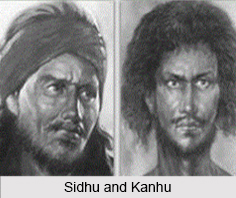 Santhal Rebellion or Santhal Hool was a native rebellion by the Santhal people, which was fought against both the British Empire and the Zamindari system. The rebellion started on 30th June 1855. The rebellion was led by the four Murmu Brothers - Sidhu, Kanhu, Chand and Bhairav. The rebellion was fought on the place, which comes under the state of Jharkhand at present days. It was a tribal reaction to end the British revenue system, usury practices and Zamindari system in India.
Santhal Rebellion or Santhal Hool was a native rebellion by the Santhal people, which was fought against both the British Empire and the Zamindari system. The rebellion started on 30th June 1855. The rebellion was led by the four Murmu Brothers - Sidhu, Kanhu, Chand and Bhairav. The rebellion was fought on the place, which comes under the state of Jharkhand at present days. It was a tribal reaction to end the British revenue system, usury practices and Zamindari system in India.
Initiation of Santhal Rebellion
Before the British period started, Santhal people resided in the districts of Manbhum, Barabhum, Chhotanagpur, Palamau, and Birbhum. Their occupations were mostly consisted of clearing forest patches, cultivation and hunting etc. But after the British came, they claimed their rights on the lands. As a result of which, Santhals retreated to the hills of Rajmahal. After a short span of time, local landlords claimed their rights to the new land as well. Zamindars and the money lenders made them work as bonded labourers by giving them loans. This dispossession turned the Santhals into rebels and finally they took an oath to give an attack on the British.
Execution of Santhal Rebellion
On 30th June 1855, Sidhu and Kanhu Murmu gathered almost ten thousand Santhals to declare the rebellion against the British colonial power. These Santhal people were accumulated to run a parallel government against the British. The basic purpose was to collect taxes by making own laws. After the declaration many Zamindars and money lenders of different villages were put to death by the Santhals. Surprised British Government by this rebellion tried to stop them, which ultimately led to failure. Then the British took a major step to prevent the rebellion by sending large number of troops, which were assisted by the local Zamindars and the Nawab of Murshidabad. Government also announced a reward of ten thousand rupees to arrest Sidhu and Kanhu Murmu. Several fights occurred during the rebellion, which led to a number of casualties for the Santhals. Their weapons could not resist the powerful musket and canons of the British. Major fighting continued to occur from July 1855 to January 1856 in different places like Kahalgaon, Suri, Raghunathpur and Munkatora etc. During the revolt Sidhu and Kanhu were killed. Santhal huts were even demolished by elephants, which were sent by the Nawab of Murshidabad. Over 15,000 Santhals were killed in this revolt and ten villages were destroyed.



















